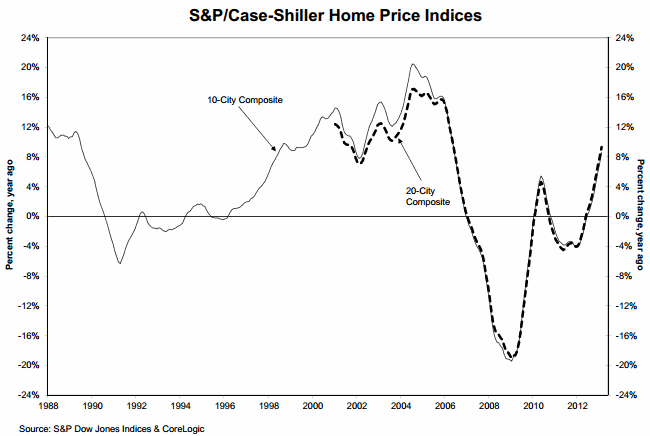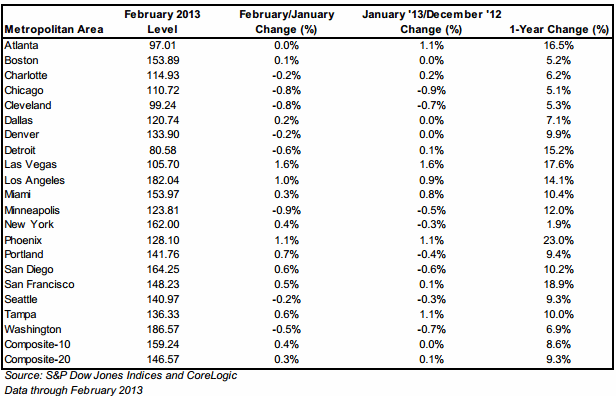Every city in the S&P Case-Shiller 20-City Composite Index has now posted annual increases for at least two consecutive months. The February 2013 indices released this morning showed year-over-year prices in the 10-City Composite gained 8.6 percent and the 20-City Composite rose 9.3 percent. In 16 of the 20 cities the annual growth rate rose in February compared to January and ten are now posting double digit positive changes.

The 10-City Composite increased 0.4 percent from January to February and the 20-City increased 0.3 percent with Las Vegas and Phoenix posting monthly increases in excess of 1 percent. Prices in all 20 cities increased on a seasonally adjusted basis with Phoenix jumping 1.8 percent and Minneapolis 1.3 percent. Eight cities had small monthly declines on a non-seasonally adjusted basis, the largest ironically being Minneapolis at -0.9 percent.
David M. Blitzer, Chairman of the Index Committee at S&P Dow Jones Indices said all 20 cities continue to show solid increases in home prices. "The 10- and 20-City Composites recorded their highest annual growth rates since May 2006; seasonally adjusted monthly data show all 20 cities saw higher prices for two months in a row - the last time that happened was in early 2005.
"Phoenix, San Francisco, Las Vegas, and Atlanta were the four cities with the highest year-over-year price increases. Atlanta recovered from a wave of foreclosures in 2012 while the other three were among the hardest hit in the housing collapse. At the other end of the rankings, three older cities - New York, Boston, and Chicago - saw the smallest year-over-year price improvements," Blitzer said.
Home prices for both city composites are back to autumn 2003 levels. Measured from their June/July 2006 peaks each of the composites show a decline of approximately 29-30 percent while the 10-City has recovered from its early 2012 low by 8.7 percent and the 20-City recovery is 9.3 percent.

Blitzer said the despite the mixed economic news in March, "housing continues to be one of the brighter spots in the economy. The 2013 first quarter GDP report shows that residential investment accelerated from the 2012 fourth quarter and made a positive contribution to growth. One open question is the mix of single family and apartments; housing data show a larger than usual share is apartments."
The S&P Home Price Indices are constructed to track the price path of a typical single-family home located in each of the metropolitan areas tracked. Each index combines matched price pairs for thousands of individual houses from armed-length sales data. The indices have a base value of 100 in January 2000 so a house with an index value of 150 has had a 50 percent increase in value since that data.







